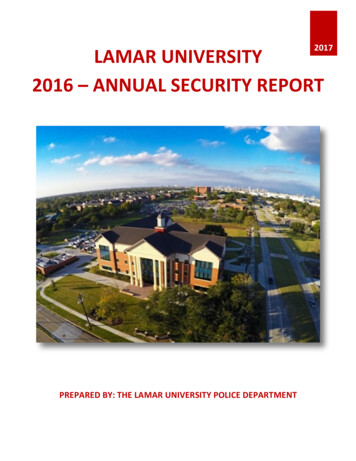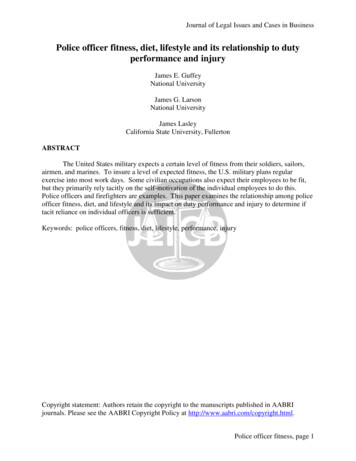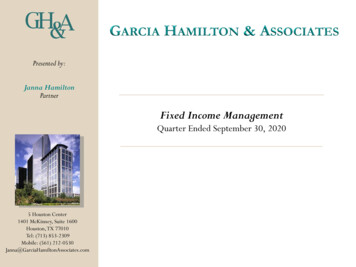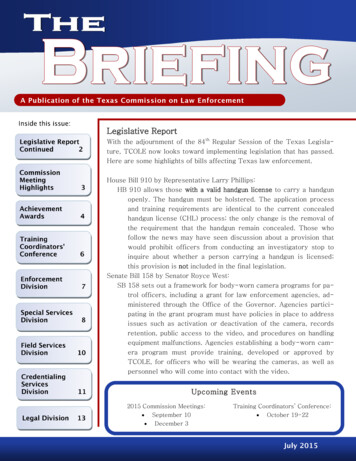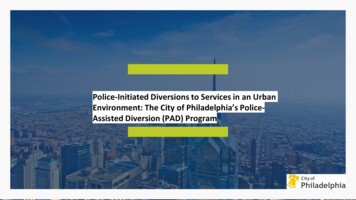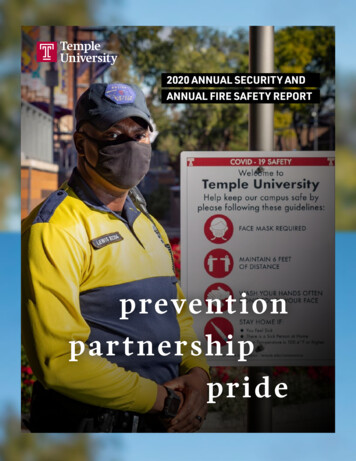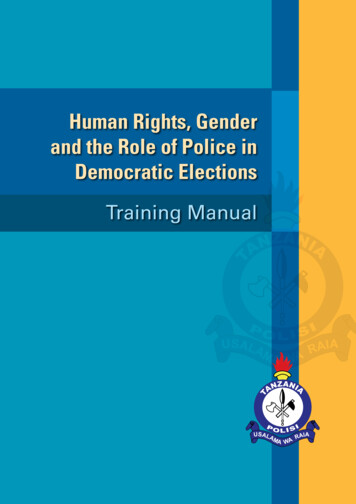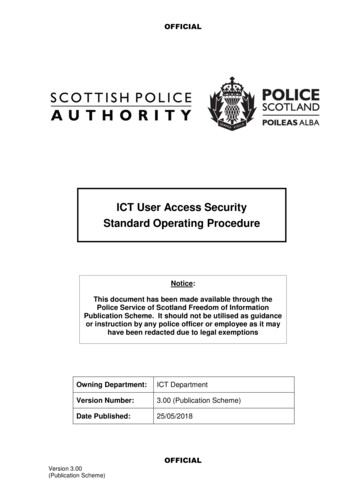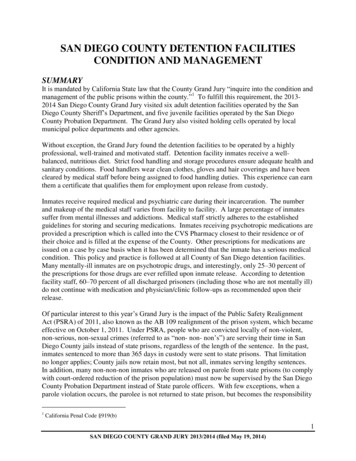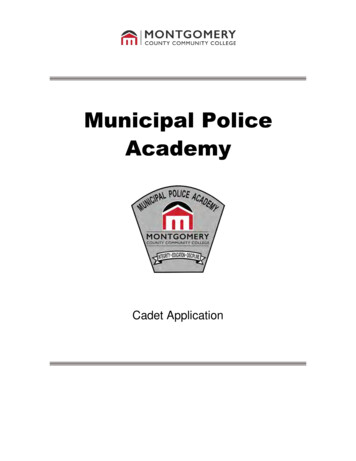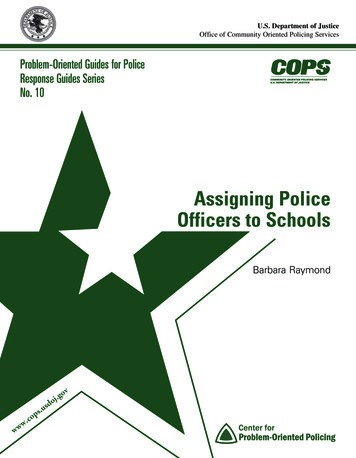
Transcription
U.S. Department of JusticeOffice of Community Oriented Policing ServicesProblem-Oriented Guides for PoliceResponse Guides SeriesNo. 10Assigning PoliceOfficers to SchoolsBarbara Raymond.cwww.ussopvgoj.do
Problem-Oriented Guides for PoliceResponse Guides SeriesGuide No. 10Assigning PoliceOfficers to SchoolsBarbara RaymondThis project was supported by cooperative agreement2006-CK-WX-K003 by the Office of Community OrientedPolicing Services, U.S. Department of Justice. The opinionscontained herein are those of the author(s) and do not necessarilyrepresent the official position of the U.S. Department of Justice.References to specific companies, products, or services should notbe considered an endorsement of the product by the author or theU.S. Department of Justice. Rather, the references are illustrationsto supplement discussion of the issues.The Internet references cited in this publication were valid as ofFebruary 2010. Given that URLs and web sites are in constantflux, neither the author nor the COPS Office can vouch for theircurrent validity. 2010 Center for Problem-Oriented Policing, Inc. The U.S.Department of Justice reserves a royalty-free, nonexclusive, andirrevocable license to reproduce, publish, or otherwise use, andauthorize others to use, this publication for Federal Governmentpurposes. This publication may be freely distributed and used fornoncommercial and educational purposes.www.cops.usdoj.govISBN: 978-1-935676-14-0April 2010
About the Response Guides SeriesAbout the Response Guide SeriesThe Response Guides are one of three series of the Problem-OrientedGuides for Police. The other two are the Problem-Specific Guidesand Problem-Solving Tools.The Problem-Oriented Guides for Police summarize knowledgeabout how police can reduce the harm caused by specific crime anddisorder problems. They are guides to preventing problems andimproving overall incident response, not to investigating offensesor handling specific incidents. Neither do they cover all of thetechnical details about how to implement specific responses. Theguides are written for police—of whatever rank or assignment—who must address the specific problems the guides cover. Theguides will be most useful to officers who: Understand basic problem-oriented policing principles andmethods Can look at problems in depth Are willing to consider new ways of doing police business Understand the value and the limits of research knowledge Are willing to work with other community agencies to findeffective solutions to problems.The Response Guides summarize knowledge about whether policeshould use certain responses to address various crime and disorderproblems, and about what effects they might expect. Each guide: Describes the response Discusses the various ways police might apply the response Explains how the response is designed to reduce crime anddisorder Examines the research knowledge about the response Addresses potential criticisms and negative consequences thatmight flow from use of the response Describes how police have applied the response to specific crimeand disorder problems, and with what effect.i
iiAssigning Police Officers to SchoolsThe Response Guides are intended to be used differently from theProblem-Specific Guides. Ideally, police should begin all strategicdecision-making by first analyzing the specific crime and disorderproblems they are confronting, and then using the analysisresults to devise particular responses. But certain responses are socommonly considered and have such potential to help address arange of specific crime and disorder problems that it makes sensefor police to learn more about what results they might expect fromthem.Readers are cautioned that the Response Guides are designed tosupplement problem analysis, not to replace it. Police should analyzeall crime and disorder problems in their local context beforeimplementing responses. Even if research knowledge suggests thata particular response has proved effective elsewhere, that does notmean the response will be effective everywhere. Local factors mattera lot in choosing which responses to use.Research and practice have further demonstrated that, in mostcases, the most effective overall approach to a problem is one thatincorporates several different responses. So a single response guideis unlikely to provide you with sufficient information on which tobase a coherent plan for addressing crime and disorder problems.Some combinations of responses work better than others. Thus,how effective a particular response is depends partly on what otherresponses police use to address the problem.These guides emphasize effectiveness and fairness as the mainconsiderations police should take into account in choosingresponses, but recognize that they are not the only considerations.Police use particular responses for reasons other than, or inaddition to, whether or not they will work, and whether or notthey are deemed fair. Community attitudes and values, andthe personalities of key decision-makers, sometimes mandate
About the Response Guides Seriesdifferent approaches to addressing crime and disorder problems.Some communities and individuals prefer enforcement-orientedresponses, whereas others prefer collaborative, community-oriented,or harm-reduction approaches. These guides will not necessarilyalter those preferences, but are intended to better inform them.The COPS Office defines community policing as “a philosophythat promotes organizational strategies, which support thesystematic use of partnerships and problem-solving techniques, toproactively address the immediate conditions that give rise to publicsafety issues such as crime, social disorder, and fear of crime.” Theseguides emphasize problem-solving and police-community partnershipsin the context of addressing specific public safety problems. For themost part, the organizational strategies that can facilitate problemsolving and police-community partnerships vary considerably anddiscussion of them is beyond the scope of these guides.These guides have drawn on research findings and police practicesin the United States, the United Kingdom, Canada, Australia, NewZealand, the Netherlands, and Scandinavia. Even though laws,customs and police practices vary from country to country, it isapparent that the police everywhere experience common problems.In a world that is becoming increasingly interconnected, it isimportant that police be aware of research and successful practicesbeyond the borders of their own countries.Each guide is informed by a thorough review of the research literatureand reported police practice, and each guide is anonymously peerreviewed by a line police officer, a police executive and a researcherprior to publication. The review process is independently managed bythe COPS Office, which solicits the reviews.iii
ivAssigning Police Officers to SchoolsFor more information about problem-oriented policing, visit theCenter for Problem-Oriented Policing online atwww.popcenter.org. This web site offers free online access to: The Problem-Specific Guides series The companion Response Guides and Problem-Solving Tools series Special publications on crime analysis and on policing terrorism Instructional information about problem-oriented policing andrelated topics An interactive problem-oriented policing training exercise An interactive Problem Analysis Module Online access to important police research and practices Information about problem-oriented policing conferences andaward programs.
AcknowledgmentsAcknowledgmentsThe Problem-Oriented Guides for Police are produced by the Centerfor Problem-Oriented Policing, whose officers are Michael S. Scott(Director), Ronald V. Clarke (Associate Director) and GraemeR. Newman (Associate Director). While each guide has a primaryauthor, other project team members, COPS Office staff andanonymous peer reviewers contributed to each guide by proposingtext, recommending research and offering suggestions on matters offormat and style.The project team that developed the guide series comprisedHerman Goldstein (University of Wisconsin Law School),Ronald V. Clarke (Rutgers University), John E. Eck (Universityof Cincinnati), Michael S. Scott (University of Wisconsin LawSchool), Rana Sampson (Police Consultant), and Deborah LammWeisel (North Carolina State University).Members of the San Diego; National City, California; andSavannah, Georgia police departments provided feedback on theguides' format and style in the early stages of the project.Debra Cohen, Ph.D. and Cynthia Pappas oversaw the project forthe COPS Office. Phyllis Schultze conducted research for theguide at Rutgers University’s Criminal Justice Library. NancyLeach coordinated the Center for Problem-Oriented Policing’sproduction process. Stephen Lynch edited this guide.The author thanks Horacio Trujillo and Aiden Sidebottom fortheir careful reviews and insightful contributions.v
ContentsContentsAbout the Response Guide Series . . . . . . . . . . . . . . . . . . . . . . . . . . . . . . . . . . iAcknowledgments. . . . . . . . . . . . . . . . . . . . . . . . . . . . . . . . . . . . . . . . . . . . . . vIntroduction. . . . . . . . . . . . . . . . . . . . . . . . . . . . . . . . . . . . . . . . . . . . . . . . . . . 1Common Roles for School Resource Officers. . . . . . . . . . . . . . . . . . . . . . . . .Safety Expert and Law Enforcer . . . . . . . . . . . . . . . . . . . . . . . . . . . . . . .Problem Solver and Liaison to Community Resources. . . . . . . . . . . . . .Educator. . . . . . . . . . . . . . . . . . . . . . . . . . . . . . . . . . . . . . . . . . . . . . . . .3345What We Know about the Effectiveness of AssigningPolice Officers to Schools . . . . . . . . . . . . . . . . . . . . . . . . . . . . . . . . . . . . . . . . 7Changes in Crime and Violence. . . . . . . . . . . . . . . . . . . . . . . . . . . . . . . . 8Success Stories in the United Kingdom and Canada. . . . . . . . . . . . . . . . 9Changes in Perceptions of Safety. . . . . . . . . . . . . . . . . . . . . . . . . . . . . 10Changes in Perceptions of Police . . . . . . . . . . . . . . . . . . . . . . . . . . . . . 11Additional Effects of Officers in Schools. . . . . . . . . . . . . . . . . . . . . . . . 11Problem Solving in Boston Schools. . . . . . . . . . . . . . . . . . . . . . . . . . . . 12Deciding Whether and How to Assign Police Officers to Schools. . . . . . . . .Police Can Improve Safety in Schools. . . . . . . . . . . . . . . . . . . . . . . . . .Be Specific - Understand Your School’s Safety Needs. . . . . . . . . .Use Data Smartly. . . . . . . . . . . . . . . . . . . . . . . . . . . . . . . . . . . . . .Develop Safety Goals. . . . . . . . . . . . . . . . . . . . . . . . . . . . . . . . . . .Develop a School Safety Plan. . . . . . . . . . . . . . . . . . . . . . . . . . . . .School Resource Officer Program Implementation. . . . . . . . . . . . . . . .Issues to Address. . . . . . . . . . . . . . . . . . . . . . . . . . . . . . . . . . . . . .Potential Challenges. . . . . . . . . . . . . . . . . . . . . . . . . . . . . . . . . . . . . . . . . . . . .Selecting and Training SROs. . . . . . . . . . . . . . . . . . . . . . . . . . . . . .Allocating a School Resource Officer’s Time . . . . . . . . . . . . . . . . .Measuring the Value of Assigning Police Officers to Schools. . . . .Establishing Operating Protocols. . . . . . . . . . . . . . . . . . . . . . . . . .Special Issues. . . . . . . . . . . . . . . . . . . . . . . . . . . . . . . . . . . . . . . . . . . .Legal Issues. . . . . . . . . . . . . . . . . . . . . . . . . . . . . . . . . . . . . . . . . .Undercover Officers. . . . . . . . . . . . . . . . . . . . . . . . . . . . . . . . . . . .15151517192022222223242630313132vii
viii Assigning Police Officers to SchoolsConclusion. . . . . . . . . . . . . . . . . . . . . . . . . . . . . . . . . . . . . . . . . . . . . . . . . . . 33Appendix: Resources for Developing Operational Proceduresfor SRO Programs. . . . . . . . . . . . . . . . . . . . . . . . . . . . . . . . . . . . . . . . . . . . . 35Endnotes. . . . . . . . . . . . . . . . . . . . . . . . . . . . . . . . . . . . . . . . . . . . . . . . . . . . 41References . . . . . . . . . . . . . . . . . . . . . . . . . . . . . . . . . . . . . . . . . . . . . . . . . . 45About the Author. . . . . . . . . . . . . . . . . . . . . . . . . . . . . . . . . . . . . . . . . . . . . . 49Other Problem-Oriented Guides for Police . . . . . . . . . . . . . . . . . . . . . . . . . . 51
Introduction1IntroductionPolice agencies have long provided services to schools.§ It has onlybeen in the past two decades, however, that assigning police officersto schools on a full-time basis has become a widespread practice.1,§§An estimated one-third of all sheriffs’ offices and almost half of allmunicipal police departments assign nearly 17,000 sworn officersto serve in schools.2 Moreover, nearly half of all public schools haveassigned police officers. These officers are commonly referred to asschool resource officers (SROs) or education resource officers.3,§§§They are intended to serve various roles: safety expert and lawenforcer, problem solver and liaison to community resources, andeducator. Assigning officers to schools is becoming increasinglypopular. SRO programs have been encouraged through federalfunding support to local jurisdictions.§§§§ As the trend towardhaving police in schools grows, it is important to understand whenand how assigning police officers to schools can be an appropriatestrategy for schools and police agencies.This guide summarizes the typical duties of SROs, synthesizes theresearch pertaining to their effectiveness, and presents issues forcommunities to bear in mind when considering the adoption of anSRO model. It will be apparent that despite their popularity, fewsystematic evaluations of the effectiveness of SROs exist. This is aconcern as evidence from evaluative research can usefully informfuture SRO programs. Consequently, this guide identifies thetype of data that can be collected in order to measure programeffectiveness. This guide does not provide a history of SROprograms nor does it describe in detail the myriad types of SROmodels currently available. Similarly, although this guide highlightsspecific issues that communities considering the implementationof SRO programs should bear in mind (such as the legal issues thatapply to police officers in schools), it is not an authoritative guideto the legal or other special issues that must be addressed with suchprograms. The guide does however provide additional resources forreaders who wish to research these issues.§The term “police” is used throughoutthis guide. It is intended to includeother law enforcement officers, such assheriff ’s deputies, as well.§§Prior to the increase in prevalenceof School Resource Officers, policepresence in schools took various forms,including visible patrols, responsesto calls for service, and criminalinvestigations.§§§The Omnibus Crime Controland Safe Schools Act of 1968, asamended, Title I, Part Q, defines aschool resource officer as “a careerlaw enforcement officer, with swornauthority, deployed in communityoriented policing, assigned by theemploying police department or agencyto work in collaboration with schoolsand community organizations.”§§§§For example, the COPS in Schoolsgrant program of the U.S. Departmentof Justice Office of CommunityOriented Policing Services (the COPSOffice) provided funding for SROsin and around primary and secondaryschools. Since 1999, the COPS Officehas awarded over 750 million tomore than 3,000 grantees, resulting inthe hiring of more than 6,500 SROs(Office of Community OrientedPolicing Services, 2008).
2Assigning Police Officers to Schools§This guide has relevancefor the high school contextas well.This guide should benefit the many stakeholders responsiblefor school safety: police, school officials, community members,students, teachers, and elected officials. It will be of particularinterest to police and school administrators who are decidingwhether to establish an SRO program and to those seeking tomanage an existing program. Finally, the discussion is intendedto provide guidance to community members and others who areinterested in working with police and schools to improve publicsafety.This Response Guide is intended to supplement school-relatedProblem-Specific Guides, which at the time of this writing include: Bullying in Schools; Acquaintance Rape of College Students§; Underage Drinking; Bomb Threats in Schools; School Vandalism and Break-ins; and Traffic Congestion Around Schools.
Common Roles for School Resource Officers3Common Rolesfor School Resource OfficersOfficers in schools provide a wide array of services. Although theirduties can vary considerably from community to community, thethree most typical roles of SROs are safety expert and law enforcer,problem solver and liaison to community resources, and educator.§Safety Expert and Law EnforcerAs sworn police officers, SROs play a unique role in preservingorder and promoting safety on campus by, for example: Assuming primary responsibility for handling calls for servicefrom the school and in coordinating the response of other policeresources Addressing crime and disorder problems, gangs, and drugactivities occurring in or around the school Making arrests and issuing citations on campus Providing leads and information to the appropriate investigativeunits Taking action against unauthorized persons on school property Serving as hall monitors, truancy enforcers, crossing guards, andoperators of metal detectors and other security devices Responding to off-campus criminal mischief that involvesstudents Serving as liaisons between the school and the police andproviding information to students and school personnel aboutlaw enforcement matters.4§These are the three primary rolesfor SROs recognized by the Officeof Community Oriented PolicingServices (1999).
4Assigning Police Officers to SchoolsBeyond serving in a crime prevention and response role, SROs arelikely to serve as first responders in the event of critical incidentsat schools, such as accidents, fires, explosions, and other lifethreatening events. In addition, SROs often support advanceplanning for managing crises, including assisting with: Developing incident response systems Developing and coordinating emergency response plans (inconjunction with other emergency responders) Incorporating law enforcement onto school crisis managementteams Developing protocols for handling specific types of emergencies Rehearsing such protocols using tabletop exercises, drills, andmock evacuations and lockdowns.5Problem Solver andLiaison to Community ResourcesIn the school setting, problem solving involves coordinated effortsamong administrators, teachers, students, parents, mental healthprofessionals, and community-based stakeholders. SROs frequentlyassist in resolving problems that are not necessarily law violations,such as bullying or disorderly behavior, but which are nonethelesssafety issues that can result in or contribute to criminal incidents.Helping resolve these problems frequently requires the officer toact as a resource liaison, referring students to professional serviceswithin both the school (guidance counselors, social workers)and the community (youth and family service organizations). Inparticular, SROs often build relationships with juvenile justicecounselors, who are responsible for supervising delinquent youths,connecting them with needed services, and recommendingdiversionary activities.
Common Roles for School Resource OfficersProblem-solving activities commonly include: Developing and expanding crime prevention efforts for students Developing and expanding community justice initiatives forstudents Assisting in identifying environmental changes that can reducecrime in or around schools Assisting in developing school policies that address crime andrecommending procedural changes to implement those policies.6EducatorA police officer can serve as a resource for classroom presentationsthat complement the educational curriculum by emphasizing thefundamental principles and skills needed for responsible citizenship,as well as by teaching topics related to policing.7 SROs can presentcourses for students, faculty, and parents. Although SROs teacha variety of classes, there is no research indicating which classesare most useful or how to ensure an officer’s effectiveness in theteaching role. Topics commonly covered in an SRO curriculuminclude: Policing as a career Criminal investigation Alcohol and drug awareness Gang and stranger awareness and resistance General crime prevention Conflict resolution Restorative justice Babysitting safety Bicycling, pedestrian, and motor vehicle safety Special crimes in which students are especially likely to beoffenders or victims, such as vandalism, shoplifting, and sexualassault by acquaintances.85
6Assigning Police Officers to SchoolsThe above describes the various services provided by SROs.Although there is considerable diversity in the structure ofprograms and the specific activities of SROs, surveys find that mostofficers spend at least half their time engaging in law enforcementactivities. Over half of SROs advise staff, students, and families,spending about a quarter of their time in this way, and one-half ofSROs engage in teaching, on average for about five hours per week.Six to seven SRO hours per week are typically devoted to otheractivities.9The variety of program structures and activities can lead toconfusion about what individual programs are meant to accomplishand how to assess and measure their effectiveness. In particular,school and police officials often conceptualize the role of the SROdifferently. Although school officials tend to view SROs as firstresponders, SROs themselves often view their roles more broadly,giving greater weight to job functions that represent an expansionof the traditional security officer role.10 For instance, more policethan principals report that SROs did more than maintain order.Police also report significantly more teaching activity than doprincipals.11
What We Know about the Effectiveness of Assigning Police Officers to SchoolsWhat We Know about the Effectivenessof Assigning Police Officers to SchoolsDespite their popularity, few studies are available which havereliably evaluated the effectiveness of SROs. Addressing this isimportant in order to inform future SRO programs and to improveour understanding on how to maximize effectiveness with limitedresources. Ideally, research should attempt to match the goalsof a specific program with its outcomes to see if the program isachieving what it is intended to and through what mechanisms. Inthe case of school resource officers, the types of benefits that schooladministrators seek from having police officers working in theirschools include: Increased safety in and around the schools Increased perceptions of safety Improved police call response times Reductions in truancy Fewer distractions from their teachers’ teaching and classpreparation duties.12Most existing SRO research does not tell us if these hoped-forbenefits are achieved. SRO research tends to be descriptive innature—it characterizes what SROs do on a daily basis, typicaltraits of SROs, and the perceptions of people involved with SROprograms.It also often addresses satisfaction with the program. Many schooladministrators and parents express satisfaction with their SROprograms, even in instances where there was initial resistance to theidea of placing police officers in schools.137
8Assigning Police Officers to SchoolsSchool administrator, teacher, and parent satisfaction is onemeasure of the value of an SRO program. However, given theinvestment that communities and the federal government havemade in hiring, training, and maintaining a police presence inschools, it is important to combine such assessments with reliableimpact evaluations to establish program effectiveness. Moreoutcome-focused research is needed to establish whether (and how)SROs are effective in reducing crime and disorder; that is, whetherthey make schools safer.Changes in Crime and ViolenceProgram evaluation is essential to determining whether a programis effective, to improving programming, and to gaining continuedfunding. However, numerous research studies note that SROprograms should do more to collect important process andoutcome evaluation data.14 Most participating police chiefs indicateno formal evaluation systems in place, and few SRO programsparticipate in independent evaluations that assess whether programgoals have been met.15Studies of SRO effectiveness that have measured actual safetyoutcomes have mixed results. Some show an improvement in safetyand a reduction in crime; others show no change. Typically, studiesthat report positive results from SRO programs rely on participants’perceptions of the effectiveness of the program rather than onobjective evidence. Other studies fail to isolate incidents of crimeand violence, so it is impossible to know whether the positive resultsstem from the presence of SROs or are the result of other factors.More studies would be helpful, particularly research to understandthe circumstances under which SRO programs are most likely to besuccessful.There is research that suggests that although SRO programsdo not significantly impact youth criminality, the presence ofan officer nonetheless can enhance school safety. For example,the presence of SROs may deter aggressive behaviors includingstudent fighting, threats, and bullying, and may make it easier for
What We Know about the Effectiveness of Assigning Police Officers to Schoolsschool administrators to maintain order in the school, addressdisorderly behavior in a timely fashion, and limit the time spenton disciplinary matters.16 Again, these are usually self-reportedmeasures. The difficulty with self-reporting is that outcomes arespeculative. It would be more useful to see data that compare thefrequency of the activities at issue both before and after the tenureof the SRO; for such data to be compelling, any changes would haveto be attributable only to the presence of the SRO and not to otherfactors.Success Stories in theUnited Kingdom and CanadaAt least two programs have evaluated specific safety outcomes andfound improvements due to the presence of police in schools. Theseare the Safer Schools Partnership (SSP) in the United Kingdomand the Toronto Police-School Districts School Resource Officerprogram. These programs hold lessons for school safety efforts inthe United States.The U.K.’s Safer Schools Partnership (SSP) is a comprehensivecommunity and school safety program that incorporates manyinterventions and partners to improve pupil safety and to createsafer working environments and safer communities.17 Thereis evidence that the SSP has reduced offending behavior andvictimization, reduced truancy rates and total absences, andhas provided safer school environments and safer routes to andfrom school. Students and staff report that they felt safer oncethe program was introduced. Other benefits of the SSP includeimprovements in educational attainment, improved multi-agencyproblem solving, improved relations between young people andthe police, and an increase in the level of respect young peoplehave for their fellow students.18 Key aspects of this program arethe comprehensive nature of the intervention, the understandingthat “school liaison officers” are but one component of an overallyouth plan that is rooted in the community, and the incorporationof school liaison officers into local neighborhood policing efforts,rather than isolated at a particular school.9
10Assigning Police Officers to SchoolsA chief accomplishment of the Toronto SRO program was theresearch effort to assess changes in safety measures at participatingschools. In general, safety measures improved. The study canbe looked to as an example of how to track the impacts of SROactivity. The Toronto study reported the following19: Students, teachers, and school administrators all reported feelingsafe in and around the school both before and after the SROprogram was implemented. Students were more likely to report being a crime victim topolice, but no more likely to report witnessing a crime after theSRO program was implemented. Reported offenses both on school grounds and in the immediatesurrounding neighborhood decreased after the SRO programwas implemented although there were more crime victims in theimmediate surrounding neighborhood during school hours.The Toronto evaluators concluded:Overall, the evaluation finds that the School Resource Officerprogram demonstrated a number of positive effec
The Response Guides are one of three series of the Problem-Oriented Guides for Police. The other two are the Problem-Specific Guides and Problem-Solving Tools. The Problem-Oriented Guides for Police summarize knowledge about how police can reduce the harm caused by specific crime and disorder problems. They are guides to preventing problems and
